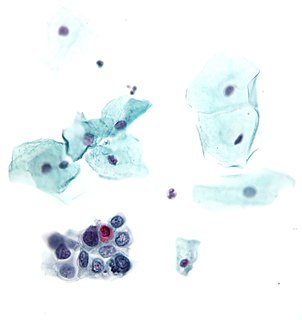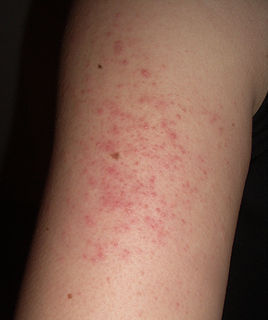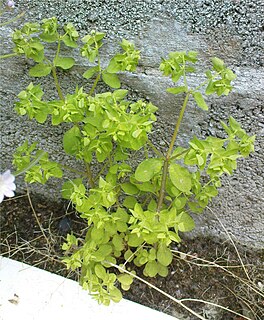Related Research Articles
Actinism is the property of solar radiation that leads to the production of photochemical and photobiological effects. Actinism is derived from the Ancient Greek ἀκτίς, ἀκτῖνος. The word actinism is found, for example, in the terminology of imaging technology, medicine, and chemistry, and the concept of actinism is applied, for example, in chemical photography and X-ray imaging.

Actinic keratosis (AK), sometimes called solar keratosis or senile keratosis, is a pre-cancerous area of thick, scaly, or crusty skin. Actinic keratosis is a disorder (-osis) of epidermal keratinocytes that is induced by ultraviolet (UV) light exposure (actin-). These growths are more common in fair-skinned people and those who are frequently in the sun. They are believed to form when skin gets damaged by UV radiation from the sun or indoor tanning beds, usually over the course of decades. Given their pre-cancerous nature, if left untreated, they may turn into a type of skin cancer called squamous cell carcinoma. Untreated lesions have up to a 20% risk of progression to squamous cell carcinoma, so treatment by a dermatologist is recommended.
Light sensitivity or photosensitivity refers to a notable or increased reactivity to light. Apart from vision, human beings have many physiological and psychological responses to light. In rare individuals an atypical response may result in serious discomfort, disease, or injury. Some drugs have a photosensitizing effect. Properties of natural or artificial light that may abnormally affect people include:

A precancerous condition is a condition or lesion involving abnormal cells which are associated with an increased risk of developing into cancer. Clinically, precancerous conditions encompass a variety of conditions or lesions with an increased risk of developing into cancer. Some of the most common precancerous conditions include certain colon polyps, which can progress into colon cancer, monoclonal gammopathy of undetermined significance, which can progress into multiple myeloma or myelodysplastic syndrome. and cervical dysplasia, which can progress into cervical cancer. Pathologically, precancerous lesions can range from benign neoplasias, which are tumors which do not invade neighboring normal tissues or spread to distant organs, to dysplasia, which involves collections of abnormal cells which in some cases have an increased risk of progressing to anaplasia and invasive cancer. Sometimes the term "precancer" is also used for carcinoma in situ, which is a noninvasive cancer that has not progressed to an aggressive, invasive stage. As with other precancerous conditions, not all carcinoma in situ will progress to invasive disease.

Keratosis is a growth of keratin on the skin or on mucous membranes stemming from keratinocytes, the prominent cell type in the epidermis. More specifically, it can refer to:

Imiquimod, sold under the brand name Aldara among others, is a medication that acts as an immune response modifier that is used to treat genital warts, superficial basal cell carcinoma, and actinic keratosis. Scientists at 3M's pharmaceuticals division discovered the drug and 3M obtained the first FDA approval in 1997. As of 2015, imiquimod is generic and is available worldwide under many brands.

Alclometasone is a synthetic corticosteroid for topical dermatologic use, possessing anti-inflammatory, antipruritic, and vasoconstrictive properties.

Euphorbia peplus, is a species of Euphorbia, native to most of Europe, northern Africa, and western Asia, where it typically grows in cultivated arable land, gardens, and other disturbed land.
Prurigo is an itchy eruption of the skin.

Actinic cheilitis is cheilitis caused by long term sunlight exposure. Essentially it is a burn, and a variant of actinic keratosis which occurs on the lip. It is a premalignant condition, as it can develop into squamous cell carcinoma.
Chronic actinic dermatitis is a condition where a subject's skin becomes inflamed due to a reaction to sunlight or artificial light. Patients often suffer from other related conditions of the skin that cause dermatitis in response to a variety of stimuli.
Actinic prurigo is a rare sunlight-induced, pruritic, papular or nodular skin eruption. Some medical experts use the term actinic prurigo to denote a rare photodermatosis that develops in childhood and is chronic and persistent; this rare photodermatosis, associated with the human leukocyte antigen HLA-DR4, is often called "Familial polymorphous light eruption of American Indians" or "Hereditary polymorphous light eruption of American Indians" but some experts consider it to be a variant of the syndrome known as polymorphous light eruption (PMLE). Some experts use the term actinic prurigo for Hutchinson's summer prurigo and several other photodermatoses that might, or might not, be distinct clinical entities.
Photorejuvenation is a skin treatment that uses lasers, intense pulsed light, or photodynamic therapy to treat skin conditions and remove effects of photoaging such as wrinkles, spots, and textures. The process induces controlled wounds on the skin, prompting it to heal itself by creating new cells. This process reverses the signs of photoaging to a certain extent by removing appearances of damage. The technique was invented by Thomas L Roberts, III using CO2 lasers in the 1990s.

Disseminated superficial actinic porokeratosis (DSAP) is a non-contagious skin condition with apparent genetic origin in the SART3 gene. It most often presents in sun-exposed areas of the body. Some DSAP cases have been reported in patients with acute immune compromised situations, particularly in the elderly. For those with sun damaged skin, the lesions usually begin to appear in the patient's 20s and increase in number and visibility in the 40s or 50s. Commonly, though not always, the number and visibility of lesions is in direct proportion to the amount of sun damage to the affected area.

Solar purpura is a skin condition characterized by large, sharply outlined, 1- to 5-cm, dark purplish-red ecchymoses appearing on the dorsa of the forearms and less often the hands.
Annular elastolytic giant-cell granuloma is a cutaneous condition characterized histologically by a dermal infiltrate of macrophages.
Actinic granuloma is a cutaneous condition characterized histologically by a dermal infiltrate of macrophages.

Actinic elastosis, also known as solar elastosis, is an accumulation of abnormal elastin in the dermis of the skin, or in the conjunctiva of the eye, which occurs as a result of the cumulative effects of prolonged and excessive sun exposure, a process known as photoaging.

Ingenol mebutate, sold under the brand name Picato, is a substance that is found in the sap of the plant Euphorbia peplus, commonly known as milkweed, and is an inducer of cell death. A gel formulation of the drug has been approved by the U.S. Food and Drug Administration (FDA) and by the European Medicines Agency (EMA) for the topical treatment of actinic keratosis. Two different strengths of the gel have been approved for use on either the face and scalp (0.015%) or the trunk and extremities (0.05%), respectively. The drug has been withdrawn from the market in the EU.
References
- ↑ James, William D.; Berger, Timothy G.; et al. (2006). Andrews' Diseases of the Skin: clinical Dermatology. Saunders Elsevier. ISBN 978-0-7216-2921-6.
| This cutaneous condition article is a stub. You can help Wikipedia by expanding it. |